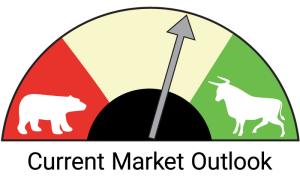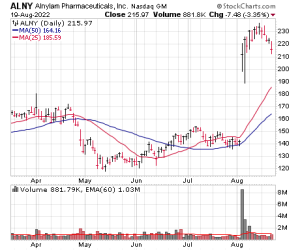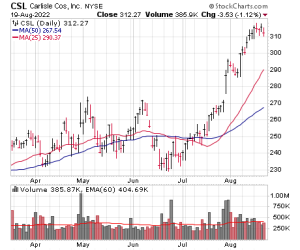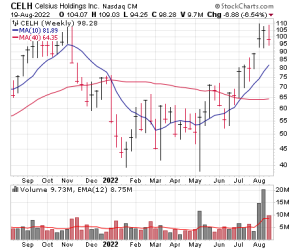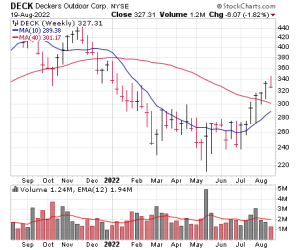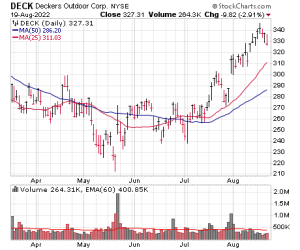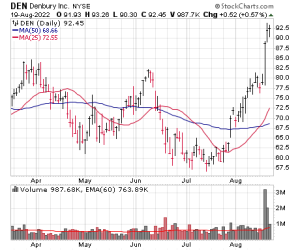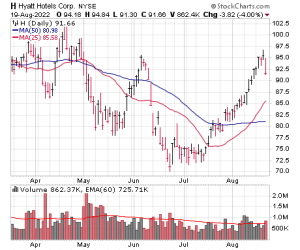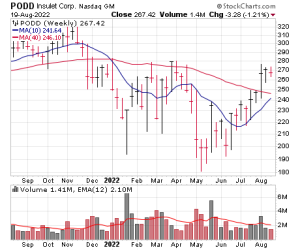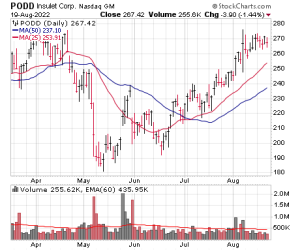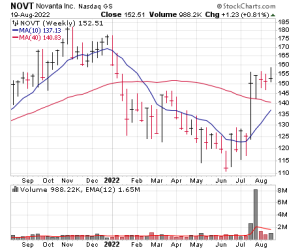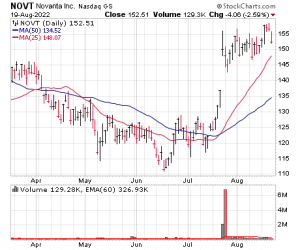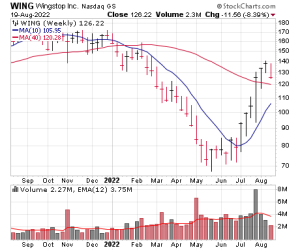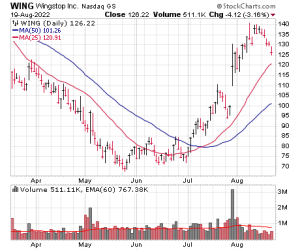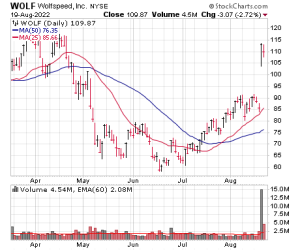As we’ve been writing in recent weeks, the evidence was clearly improving in a step-by-step manner, but few stocks were hitting new highs and the market’s longer-term trend remained down. Thus, it’s not a shock that, after a few good weeks, the sellers are beginning to step up. The question is whether the recent rally has run its course, and we’ll just take it as it comes: So far, the dip has been acceptable, but what happens from here will be key, with continued slippage likely having us pare back (possibly quickly).
This week’s list has a broad mix of names, some of which would look good on modest weakness. Our Top Pick is a potential new leader in the chip space after it gapped up huge on earnings last week.
Cabot Top Ten Trader Issue: August 22, 2022
DOWNLOAD ISSUE PDF
Here Comes the TestAs we’ve been writing in recent weeks, the evidence was clearly improving in a step-by-step manner, which had us slowly extending our line—but the key phrase there was slowly, as few stocks were hitting new highs and the market’s longer-term trend remained down. Thus, it’s not a shock that, after a few good weeks, the sellers are beginning to step up, with the major indexes and most stocks taking hits after many tested key resistance (declining 200-day lines). The question, of course, is whether the recent rally has run its course, and as always, we’ll just take it as it comes: So far, the dip has been acceptable, both for the indexes and leading stocks, so if you’re sitting on a lot of cash or looking to add a name, we’re not opposed to pulling the trigger as some decent risk/reward situations are emerging. But, clearly, what happens from here will be key, with continued slippage likely having us pare back (possibly quickly). Right now, we’re keeping our Market Monitor at a level 6, but be sure to honor your stops should the sellers keep at it.
This week’s list has a broad mix of names, some of which would look good on modest weakness. Our Top Pick is Wolfspeed (WOLF), which isn’t free and clear but showed outstanding power last week after earnings.
| Stock Name | Price | Buy Range | Loss Limit |
| Alnylam (ALNY) | 219 | 208-215 | 183-187 |
| Carlisle Co. (CSL) | 308 | 297-307 | 265-270 |
| Celsius (CELH) | 104 | 100-105 | 82-85 |
| Deckers Outdoor (DECK) | 327 | 318-324 | 290-294 |
| Denbury (DEN) | 91 | 86-89 | 77-79 |
| Hyatt (H) | 90 | 94-96 | 84-86 |
| Insulet (PODD) | 263 | 257-264 | 236-240 |
| Novanta (NOVT) | 147 | 145-148.5 | 133-135 |
| Wingstop (WING) | 119 | 115-120 | 103-105 |
| Wolfspeed (WOLF) ★ TOP PICK ★ | 107 | 104-109 | 87-90 |
Stock 1
Alnylam (ALNY)
| Price | Buy Range | Loss Limit |
| 219 | 205-215 | 183-187 |
Why the Strength
RNA interference (RNAi) is a relatively new class of therapeutics, in which treatments focus on disabling the effectiveness of genes that cause specific diseases. Alnylam is the leader in commercializing RNAi treatments, having been researching drugs in the area for 20 years. Investors are especially excited about a promising new treatment, Apollo-B, which addresses ATTR Amyloidosis, a rare, fatal disease in which a misfolded protein – TTR – causes a build up of another protein (called amyloid) in organs, leading to a lack of tolerance for exercise, heart disease and other risky conditions. Initial data from the Phase III study of Apollo-B seems promising, and investors sent shares up 49% the session after preliminary results were disclosed. Alnylam estimates there are 50,000 people worldwide who have hereditary expressions of the disease, with perhaps 300,000 more with Wild-Type ATTR, which displays itself as people age and affects mainly on the heart. Full results of Apollo-B will be presented on September 3, and assuming the deeper data reflects the August announcement, expectations are that Apollo-B will be the basis for a host of new treatments to come to market through the rest of the decade; some analysts seeing sales rising to $3.6 billion by 2031, about four times larger than today. Alnylam already has a strong business in RNAi treatments, posting a 33% rise in direct product sales last quarter from three drugs that treat ultra-rare conditions including expressions of ATTR, acute hepatic porphyria and primary hyperoxaluria type 1. Overall revenue was up just 2% in the quarter due to revenue for work the company performs for Regeneron, which is highly variable and is expected to be much higher the back half of this year and 2023. It’s an interesting speculation.
Technical Analysis
ALNY topped late last year and ended up sliding 45% from high to low—and, frankly, it didn’t look like a leader when biotech stocks began to show relative strength, either. But the recent big gap higher on the clinical data clearly changed the landscape, and just as important, the fact that ALNY has only given ground grudgingly after the giant move (and with the market’s latest stumble) is a solid sign. We still favor aiming for further dips if you want in.
| Market Cap | $25.8B | EPS $ Annual (Dec) | |
| Forward P/E | N/A | FY 2020 | -6.38 |
| Current P/E | N/A | FY 2021 | -6.14 |
| Annual Revenue | $885M | FY 2022e | -7.39 |
| Profit Margin | N/A | FY 2023e | -4.30 |
| Qtrly Rev | Qtrly Rev Growth | Qtrly EPS | Qtrly EPS Growth |
| ($M) | (vs. yr-ago-qtr) | ($) | (vs.yr-ago-qtr) |
| Latest qtr | 225 | 2% | -2.03 | N/A |
| One qtr ago | 213 | 20% | -1.49 | N/A |
| Two qtrs ago | 259 | 58% | -1.69 | N/A |
| Three qtrs ago | 188 | 49% | -1.51 | N/A |
Stock 2
Carlisle Co. (CSL)
| Price | Buy Range | Loss Limit |
| 308 | 297-307 | 265-270 |
Why the Strength
Diversification can be a very good thing in an uncertain economic environment, and Carlisle is one of the most highly diversified companies in the industrial sector. The firm is a leading manufacturer and supplier of engineered materials used in a wide array of industries, including construction, energy, mining, agriculture, aerospace and electronics. The company operates under four main segments: Construction Materials (broad range of commercial, residential and industrial building products), Interconnect Technologies (wiring, cable and optical fiber used in medical, military and test applications), Fluid Technologies (mixing and spray coatings used in automotive, industrial and refinishing markets) and Waterproofing (clays and sealants). Strong commercial construction and re-roofing demand, coupled with increasing demand for energy efficient solutions in buildings, led a record second quarter for Carlisle. Revenue of $1.8 billion soared 57% from a year ago, with per-share earnings of $6.15 beating estimates by 23% and adjusted EBITDA increasing an eye-popping 146%. Further contributing to the stellar results was Carlisle’s commitment to its new product pipeline, which accounted for over $100 million in Q2 sales, while the company’s acquisition of building envelope systems firm Henry Company boosted Waterproofing sales (the revenue leader for Q2, up 120%). Carlisle also raised the dividend by 39%, continuing a 45-year trend of continuous dividend increases (though the yield is just 1%). All in all, earnings are likely to take a step-function rise this year and tack on further gains in 2023.
Technical Analysis
CSL has been choppy and tedious in 2022, but even so, shares have shown solid relative strength: The stock did dip to its 40-week line in January and February, but spurted to new highs in April before another pullback to the 40-week line in June. But now that the pressure has come off the market, CSL has rallied beautifully, with eight weeks up in a row before last week’s tight action. Dips toward 300 would be interesting.
| Market Cap | $16.1B | EPS $ Annual (Dec) | |
| Forward P/E | 16 | FY 2020 | 7.78 |
| Current P/E | 19 | FY 2021 | 9.44 |
| Annual Revenue | $6.05B | FY 2022e | 19.88 |
| Profit Margin | 17.5% | FY 2023e | 21.17 |
| Qtrly Rev | Qtrly Rev Growth | Qtrly EPS | Qtrly EPS Growth |
| ($M) | (vs. yr-ago-qtr) | ($) | (vs.yr-ago-qtr) |
| Latest qtr | 1.85 | 57% | 6.15 | 185% |
| One qtr ago | 1.5 | 59% | 4.26 | 209% |
| Two qtrs ago | 1.38 | 39% | 2.92 | 60% |
| Three qtrs ago | 1.32 | 24% | 2.99 | 27% |
Stock 3
Celsius (CELH)
| Price | Buy Range | Loss Limit |
| 104 | 100-105 | 82-85 |
Why the Strength
New product? Check. Mass market story? Check. Triple digit growth of sales and earnings? Check. Huge recent catalyst to keep growth humming. Check. Celsius checks many of the most important boxes when looking for market leaders, and we think the stock itself is acting like it can see higher prices should the market cooperate. To review, the firm’s energy drinks (which have no preservatives, aspartame, added sodium, etc.) have been shown to actually boost metabolism by a couple of neutral studies (via thermogenesis, where the body produces heat), and partly due to that it looks like the next big thing in the industry—in the 12 weeks ended July 10, Celsius accounted for 34% of the industry’s growth, driven in part by increased distribution (1,337 club locations, up about 175 from the prior quarter; 82,000 convenience stores, nearly double from a year ago; it’s also the #2 energy drink seller on Amazon, just a bit behind Monster)—and while progress there has been great, it’s about to get a huge boost, as the recent partnership with Pepsi (which saw that firm invest $550 million in convertible preferred Celsius stock, representing about 8% ownership) should boost distribution by an additional 40% (possibly much more) above what Celsius already had planned for the next 12 months! Near-term, there are some margin worries (club store sales have lower margins, while cost and shipping inflation have taken their bite), though management sees margins marching higher going forward. All in all, sales and earnings are exploding and Wall Street sees that trend continuing for many quarters to come. It’s a great story.
Technical Analysis
CELH had a huge drop with the market beginning in November, falling from 110 to 40 in just a few months—but that was effectively the bottom, with the stock holding that support area in January, March and a third time in May before finally perking up. CELH lifted above some resistance in early July and boomed back toward its old highs after the Pepsi news. Shares have since hesitated for a couple of weeks, and while a deeper pullback is possible, we think the stock acts fine given the run and the market’s recent wobbles. We’re OK starting a small position here or on dips, but use a loose stop.
| Market Cap | $7.41B | EPS $ Annual (Dec) | |
| Forward P/E | 233 | FY 2020 | 0.11 |
| Current P/E | 429 | FY 2021 | 0.05 |
| Annual Revenue | $486M | FY 2022e | 0.42 |
| Profit Margin | 5.9% | FY 2023e | 1.25 |
| Qtrly Rev | Qtrly Rev Growth | Qtrly EPS | Qtrly EPS Growth |
| ($M) | (vs. yr-ago-qtr) | ($) | (vs.yr-ago-qtr) |
| Latest qtr | 154 | 137% | 0.12 | 999% |
| One qtr ago | 133 | 167% | 0.09 | 800% |
| Two qtrs ago | 104 | 192% | 0.15 | 650% |
| Three qtrs ago | 94.9 | 158% | -0.12 | N/A |
Stock 4
Deckers Outdoor (DECK)
| Price | Buy Range | Loss Limit |
| 327 | 318-324 | 290-294 |
Why the Strength
Like many players in the lifestyle apparel space, Deckers has suffered from limited operating capacity due to supply-chain disruptions. But despite these challenges, the company continues to grow with plans to expand its retail footprint in the coming year. Deckers is known for the premium footwear it designs and sells, including its staple brand Ugg (the iconic fuzzy boots and slippers) and the Hoka One brand of running shoes. Deckers got off to a strong start in fiscal 2023 (which started April 1), posting estimate-beating Q1 sales of $615 million that increased 22% from a year ago, along with per-share earnings of $1.66 that were 45 cents above estimates. While Ugg sales decreased 2%, the momentum was led by higher penetration of the firm’s Hoka brand, which saw sales jump 55% while achieving a billion-dollar milestone on a trailing twelve-month basis. Deckers has been rolling out pop-up Hoka stores in big cities across the U.S., and the company plans to open its first physical retail store in New York by the spring of next year. Moreover, Hoka has partnered with footwear giant Foot Locker, a move that Deckers believes will increase the brand’s reach with a younger demographic. Direct-to-consumer (DTC) sales increased 15% to $185 million, and the company continues to see higher sales in its digital channels, with online sales accounting for most of Hoka’s revenue. Going forward, management plans to build Hoka into a “multibillion-dollar player in the performance athletic space” and expressed confidence in the company’s direction by recently approving a $1.2 billion share buyback authorization increase. Wall Street sees earnings growth mid teens this year and next.
Technical Analysis
DECK reached an all-time peak at 450 last September and retested that high in November before finally giving up the ghost, tumbling to 232 in March. But that was effectively the start of the bottoming process; there was a brief dip to 215 in May but that was quickly recovered, with DECK basically going sideways for four months. And since then we see a six-week-in-a-row run above the 200-day line and a modest, low-volume dip last week. If you’re game, dips of a few more points would be a decent entry point.
| Market Cap | $8.78B | EPS $ Annual (Mar) | |
| Forward P/E | 18 | FY 2021 | 13.47 |
| Current P/E | 21 | FY 2022 | 16.26 |
| Annual Revenue | $3.26B | FY 2023e | 18.13 |
| Profit Margin | 7.3% | FY 2024e | 21.43 |
| Qtrly Rev | Qtrly Rev Growth | Qtrly EPS | Qtrly EPS Growth |
| ($M) | (vs. yr-ago-qtr) | ($) | (vs.yr-ago-qtr) |
| Latest qtr | 615 | 22% | 1.66 | -3% |
| One qtr ago | 736 | 31% | 2.51 | 113% |
| Two qtrs ago | 1188 | 10% | 8.42 | -6% |
| Three qtrs ago | 722 | 16% | 3.66 | 2% |
Stock 5
Denbury (DEN)
| Price | Buy Range | Loss Limit |
| 91 | 86-89 | 77-79 |
Why the Strength
Carbon capture utilization and storage (known as CCUS) has become a hot topic for energy companies in recent years, as oil and gas producers are under pressure to reduce carbon emissions. The costs involved in CCUS are huge and will require years before most energy firms can fully address it, but Denbury has a big head start on its competitors. Denbury operates mainly in the Gulf Coast and Rocky Mountain regions, with most of its reserves (97%) in oil. But what separates the company from other energy firms is its focus on carbon dioxide enhanced oil recovery (CO2-EOR), a technique that allows for (a) significantly higher oil extraction from a reservoir by utilizing CO2 in the extraction process, while (b) reducing the carbon footprint of the oil produced. Denbury’s long-term goal is to fully offset its CO2 emissions using this method, and its strategy involves buying mature oil properties that have reached their limits using traditional extraction methods, then using CO2-EOR to revitalize the wells and continue cranking oil from them. Part of the recent strength was due to a Bloomberg report that the company is exploring a sale of its operations (though the company has declined to comment). But another source of the strength was Denbury’s eye-opening Q2 report, which saw revenue of $482 million increase 60% from a year ago and per-share earnings of $2.83 that rallied 177%. Denbury’s operating activities allowed it to generate $55 million in free cash flow in Q2 (up 244%) and $106 million year-to-date (up 27%). The company also signed an agreement for a planned CO2 storage site in Louisiana, exited the quarter with zero debt and repurchased $100 million in stock (2%-plus of shares outstanding). Analysts see the bottom line soaring 178% in 2022.
Technical Analysis
DEN came public at 21 in September 2020 and, after a few weeks of consolidation, rocketed all the way to 90 by the following November. The stock, though, was capped after that, missing out on the broad energy sector advance for most of this year, with the stock hitting a low in July near 58. But the past four weeks have seen a huge change in character, helped along by the buyout rumors, which admittedly add some uncertainty. Still, we’re fine picking up a few shares on further weakness.
| Market Cap | $4.64B | EPS $ Annual (Dec) | |
| Forward P/E | 13 | FY 2020 | 0.88 |
| Current P/E | 19 | FY 2021 | 2.56 |
| Annual Revenue | $1.60B | FY 2022e | 7.12 |
| Profit Margin | 19.3% | FY 2023e | 9.10 |
| Qtrly Rev | Qtrly Rev Growth | Qtrly EPS | Qtrly EPS Growth |
| ($M) | (vs. yr-ago-qtr) | ($) | (vs.yr-ago-qtr) |
| Latest qtr | 482 | 60% | 1.69 | 177% |
| One qtr ago | 412 | 64% | 1.69 | 284% |
| Two qtrs ago | 362 | 84% | 0.76 | 31% |
| Three qtrs ago | 344 | 78% | 0.74 | 85% |
Stock 6
Hyatt (H)
| Price | Buy Range | Loss Limit |
| 90 | 94-96 | 84-86 |
Why the Strength
As leisure travel rebounds following the pandemic-related setbacks of the past couple of years, hotel operator Hyatt has been gearing up to meet pent-up travel demand by increasing its lineup of luxury brands. Three of its upscale brands—Destination, Unbound Collection and JdV—helped drive revenue per available room (RevPAR) in the Americas and Southwest Asia regions during the second quarter (up 22%), which is even more impressive given the company has doubled the number of luxury rooms in its system in recent years. Hyatt is also seeing RevPAR surge in the Asia Pacific, with comparable system-wide RevPAR soaring 82% and exceeding pre-pandemic levels (when excluding Greater China), while that metric improved 85% for Hyatt’s U.S. hotels. System-wide net rooms growth, meanwhile, was 19% higher in the second quarter—a trend Hyatt expects will continue, with an estimated 6%-plus rooms’ growth forecast for the full year due to a spate of new hotel openings in the back half of 2022. Total fee revenue exceeded $200 million and was 27% higher than any other quarter in the company’s history, driven by a record level of leisure travel revenue and “rapidly improving” group and business travel demand. All told, revenue for Q2 increased 124% to $1.5 billion, while EPS of $0.46 crushed estimates by 40 cents. Going forward, Hyatt remains active in new property acquisitions, including its latest purchase of the Hotel Irvine in California, with plans to renovate and reposition the hotel. Management guided for this year’s comparable system-wide RevPAR to exceed last year’s by around 60%, while Wall Street sees the new travel boom continuing for many quarters to come.
Technical Analysis
H hit all-time highs in November, January and again in February as business soared, but the market finally got its claws in the stock, resulting in three legs down (82 in March, 78 in May and 70 in June). Really, though, the damage wasn’t that bad given the bear phase, and H then tightened up and got going, rallying five weeks in a row back above its 200-day line. There’s still plenty of resistance above here, so we’re going to set our buy range a bit higher than here, thinking a rebound from the recent selling would result in good things.
| Market Cap | $10.0B | EPS $ Annual (Dec) | |
| Forward P/E | 200 | FY 2020 | -5.40 |
| Current P/E | N/A | FY 2021 | -5.24 |
| Annual Revenue | $4.69B | FY 2022e | 0.46 |
| Profit Margin | 3.4% | FY 2023e | 1.89 |
| Qtrly Rev | Qtrly Rev Growth | Qtrly EPS | Qtrly EPS Growth |
| ($M) | (vs. yr-ago-qtr) | ($) | (vs.yr-ago-qtr) |
| Latest qtr | 1.48 | 124% | 0.46 | N/A |
| One qtr ago | 1.28 | 192% | -0.33 | N/A |
| Two qtrs ago | 1.08 | 154% | -2.78 | N/A |
| Three qtrs ago | 0.85 | 113% | 2.31 | N/A |
Stock 7
Insulet (PODD)
| Price | Buy Range | Loss Limit |
| 263 | 257-264 | 236-240 |
Why the Strength
Diabetes is one of America’s top five chronic diseases, with more than one in three adults having pre-diabetes, making insulin management a paramount concern. Insulet is a medical device maker focused on systems of insulin delivery and management for diabetes patients. Its wearable, disposable Omnipod product platform offers needle-free alternatives to traditional insulin delivery methods and provides up to three days of non-stop insulin delivery. Aside from being lighter weight and less invasive than most insulin pump systems, Omnipod can be adjusted to increase the insulin dose when eating higher-carb meals or sugary snacks. On the financial front, while Insulet missed its EPS estimate by 73 cents in Q2, revenue of $300 million beat Wall Street’s expectations and was 14% higher from a year ago. And while drug delivery revenues were lower, Omnipod sales grew 31% in the U.S. and 9% internationally (on a constant currency basis). More importantly, the company achieved record quarterly U.S. and total new customer starts, while completing a successful retail rollout of the Omnipod 5 system (first tubeless automated insulin delivery system in the U.S.), both of which bode well going ahead. Management guided for full-year revenue to increase 16%, including a projected 25% U.S. sales bump for Omnipod, with accelerating growth likely going forward—bolstered in part by today’s FDA approval of Omnipod 5 for children two and over with Type 1 diabetes (the approval from January of this year covered those six and older). It’s a solid story that should grow steadily for a long time.
Technical Analysis
PODD had a choppy but constructive run higher for much of 2019 through 2020, though it basically ran out of gas in January 2021 and topped for good last November. Shares quickly sank from there, eventually bottoming near 180 in May before the buyers returned. And since then, the action has been solid—not amazing, but steady, with PODD rallying well above its 200-day line after earnings. We’re OK grabbing a few shares here or on further weakness.
| Market Cap | $18.5B | EPS $ Annual (Dec) | |
| Forward P/E | 618 | FY 2020 | 0.10 |
| Current P/E | 543 | FY 2021 | 0.24 |
| Annual Revenue | $1.18B | FY 2022e | 0.43 |
| Profit Margin | N/A | FY 2023e | 1.45 |
| Qtrly Rev | Qtrly Rev Growth | Qtrly EPS | Qtrly EPS Growth |
| ($M) | (vs. yr-ago-qtr) | ($) | (vs.yr-ago-qtr) |
| Latest qtr | 299 | 14% | -0.50 | N/A |
| One qtr ago | 295 | 17% | 0.40 | 999% |
| Two qtrs ago | 308 | 25% | 0.42 | N/A |
| Three qtrs ago | 276 | 18% | 0.18 | 6% |
Stock 8
Novanta (NOVT)
| Price | Buy Range | Loss Limit |
| 147 | 145-148.5 | 133-135 |
Why the Strength
Novanta provides precision components for robotics, including arms used in surgery and manufacturing as well as tools that optimize the use of lasers; the business has eight subsidiaries focusing on supplying original equipment manufacturers. Historically, Novanta centered efforts on health care – it doesn’t make full robotic surgery platforms, but instead provides highly precise parts, such as force/torque sensors, robotic joints and fluid and gas management solutions. Medical robotics continues to have a strong growth profile, helping the business post a 29% increase in revenue in its recently reported second quarter. Those sales, reported this month, hit $215 million with net profit of $0.78 a share. That beat expectations and prompted management to raise guidance for the full year to about $850 million, which would be a 20% gain over 2021. Minimally invasive and elective surgeries are emerging from most COVID-19 restrictions in the U.S. and Europe, powering growth, while in China, Novanta managed to keep sales level despite that country’s continuing stop-start pattern around the pandemic. The outlook is good in part because the pandemic has led to orders by customers who want spare parts in stock, leaving Novanta with $653 million in inventory. That’s a lot, but management says all of it is committed to orders that recipients can’t cancel and will take delivery of by mid-2023. Longer term, robotic technologies are primed to explode in general manufacturing, thanks to what’s dubbed Industry 4.0, where AI and Internet of Things push assembly lines to another big step forward. In particular, Novanta says it sees strong interest in using its robotics in EV and related battery production, especially in China. Analysts see earnings up mid teens this year and next.
Technical Analysis
Though it was a smaller-cap name, NOVT had a mostly smooth advance in 2020 and 2021 before finally getting caught in the selling storm, falling from 184 in November to 124 in January and then as low as 111 in June. But the rebound has been super impressive, bolstered at first by an index addition (to the S&P 400 MidCap) in late July, with the earnings report solidifying its position above its 200-day line. We’re OK nibbling on this sharp (but normal) pullback if you want in.
| Market Cap | $5.55B | EPS $ Annual (Dec) | |
| Forward P/E | 49 | FY 2020 | 1.95 |
| Current P/E | 53 | FY 2021 | 2.62 |
| Annual Revenue | $796M | FY 2022e | 3.09 |
| Profit Margin | 13.0% | FY 2023e | 3.75 |
| Qtrly Rev | Qtrly Rev Growth | Qtrly EPS | Qtrly EPS Growth |
| ($M) | (vs. yr-ago-qtr) | ($) | (vs.yr-ago-qtr) |
| Latest qtr | 215 | 29% | 0.78 | 26% |
| One qtr ago | 204 | 26% | 0.73 | 26% |
| Two qtrs ago | 199 | 35% | 0.67 | 26% |
| Three qtrs ago | 178 | 24% | 0.75 | 79% |
Stock 9
Wingstop (WING)
| Price | Buy Range | Loss Limit |
| 119 | 115-120 | 103-105 |
Why the Strength
Wingstop was always a great cookie-cutter story, with a simple set of offerings (tasty wings with a bunch of seasoning choices, as well as thighs and (soon) chicken sandwiches, plus some pub fare like fries and the like) and small-form (less expensive) stores that led the company to expand rapidly and aim to be a top 10 restaurant brand over time. But the pandemic messed things up—first in a good way, accelerating growth (the firm’s digital ordering system, which still brings in 60% of revenue, was always among the best in the industry) and then leading to a slowdown as the world turned right-side up, with elevated wing costs also contributing to some soggy sales and earnings numbers. But now things are perking up again as focus returns to the underlying story: In Q2, not only did sales (up 13%) and earnings (up 18%) do just fine, but new store growth remained in fifth gear (restaurant count was up 14% from a year ago; new stores pay back the initial investment in less than two years) and management sees the recent dip in wing prices boosting the bottom line going forward as same-store sales begin to turn around. But the real story is the overall outlook, with the top brass seeing room for 4,000 locations in the U.S. (vs. 1,600 today) and 3,000 overseas (vs. just 219 today; they want to have 1,200 overseas within 10 years), all while same-store sales lift at low- to mid-single digit rates. The valuation remains up there and wing costs are always a wild card, but Wingstop is likely re-entering a period of consistent growth that could last for many years to come.
Technical Analysis
WING’s sharp post-crash run petered out early on (fall of 2020), with the stock meandering for a year after that before imploding in recent months, falling from 170 to below 70 in the first four-plus months of 2022. Interestingly, the stock didn’t build much of a bottom, hovering around 80 for a few weeks, and then took off before before and after earnings (six weeks up in a row), rallying back above its 200-day line. Now WING is pulling back with everything else on very light trade—we’re OK taking a stab at it here or a bit lower.
| Market Cap | $3.77B | EPS $ Annual (Dec) | |
| Forward P/E | 80 | FY 2020 | 1.09 |
| Current P/E | 99 | FY 2021 | 1.35 |
| Annual Revenue | $298M | FY 2022e | 1.57 |
| Profit Margin | 16.2% | FY 2023e | 1.87 |
| Qtrly Rev | Qtrly Rev Growth | Qtrly EPS | Qtrly EPS Growth |
| ($M) | (vs. yr-ago-qtr) | ($) | (vs.yr-ago-qtr) |
| Latest qtr | 83.8 | 13% | 0.45 | 18% |
| One qtr ago | 76.2 | 8% | 0.34 | -23% |
| Two qtrs ago | 72 | 14% | 0.23 | 28% |
| Three qtrs ago | 65.8 | 3% | 0.29 | -6% |
Stock 10
Wolfspeed (WOLF) ★ TOP PICK ★
| Price | Buy Range | Loss Limit |
| 107 | 104-109 | 87-90 |
Why the Strength
There’s a huge shift getting started in huge swaths of the chip industry, and it’s all about silicon carbide (SiC) chips, a material that results in semis that have far greater efficiency, especially at higher temperatures, making them much better for applications like electric vehicles (plus their charging infrastructure) and 5G base stations, not to mention tons of other power-hungry devices, too. Wolfspeed is aiming to be the leader in SiC chips, building the first automated 200 mm SiC facility this year (it’s doing rest runs now; production will start in the next six to nine months) and is rapidly expanding material and chip capacity elsewhere. And having that potential capacity available in the years ahead has led clients to beat a path to their door: The firm’s design-in activity each quarter (offerings that are being designed into client’s future products) has been massive, with a recent quarterly record of $1.6 billion (which was itself 60% higher than the prior record) being smashed in Q2, when Wolfspeed garnered $2.6 billion of design-ins thanks to a quicker SiC adoption and higher-than-expected win rates. All told, the top brass thinks revenues can now grow from $746 million in the just-ended fiscal year to $2.8 billion (!) in just four years; nearer-term, analysts see sales and (next year) earnings taking off. The risks here is that the company is expanding (spending money) like mad to boost capacity to meet the huge demand, so a credit crunch might hurt things; and Wolfspeed isn’t the only SiC player by any stretch (Onsemi is another big one). But this firm is certainly one of the leaders—we like the story a lot.
Technical Analysis
WOLF looked to have a coming out party last November when the stock took flight on SiC hopes, but the market topped out near the same time and pulled the stock down from 140 to 80 in January and under 60 in June. The recovery from that low started off slow, but gained steam, with shares rallying six weeks up in a row before last week’s game changer—WOLF exploded higher on its highest weekly volume in five years (!) after earnings. If you’re game, a small position here or on weakness sounds fine by us.
| Market Cap | $13.6B | EPS $ Annual (Jun) | |
| Forward P/E | N/A | FY 2021 | -0.93 |
| Current P/E | N/A | FY 2022 | -0.50 |
| Annual Revenue | $727M | FY 2023e | 0.15 |
| Profit Margin | N/A | FY 2024e | 1.74 |
| Qtrly Rev | Qtrly Rev Growth | Qtrly EPS | Qtrly EPS Growth |
| ($M) | (vs. yr-ago-qtr) | ($) | (vs.yr-ago-qtr) |
| Latest qtr | 229 | 57% | -0.02 | N/A |
| One qtr ago | 188 | 37% | -0.12 | N/A |
| Two qtrs ago | 173 | 36% | -0.16 | N/A |
| Three qtrs ago | 137 | 36% | -0.21 | N/A |
Previously Recommended Stocks
Below you’ll find Cabot Top Ten Trader recommended stocks. Those rated HOLD are stocks that traded within our suggested buy range within two weeks of appearing in the Top Ten and still look good; hold if you own them. Stocks rated WAIT have yet to dip into our suggested buy range … but can be bought if they do so within the next week.
Those stocks rated SELL should be sold if you own them; they will no longer be listed here. Finally, Stocks in the DROPPED category are those that failed to trade within our buy range within two weeks of our recommendation; that’s not a bad thing, we just never got the price we wanted. Please use this list to keep up with our latest thinking, and don’t hesitate to call or email us with any questions you may have. New recommendations each week are in bold.
| Date | Stock | Symbol | Top Pick | Original Buy Range | Price as of 8/22/2022 |
| HOLD |
| 8/15/22 | Albermarle | ALB | ★ | 272-283 | 275 |
| 7/5/22 | Alliance Resource Ptnr | ARLP | | 17.3-18.3 | 25 |
| 6/21/22 | Argenx | ARGX | | 345-355 | 388 |
| 8/15/22 | Arista Networks | ANET | | 123-127 | 127 |
| 7/18/22 | Axonics | AXNX | | 60-62 | 72 |
| 6/27/22 | Biomarin Pharm | BMRN | | 83-86 | 92 |
| 8/1/22 | Cadence Design | CDNS | ★ | 178-183 | 185 |
| 5/16/22 | Celsius | CELH | | 53-56 | 104 |
| 8/15/22 | CF Industries | CF | | 98.5-101.5 | 106 |
| 7/18/22 | Consol Energy | CEIX | | 53.5-56.5 | 75 |
| 7/25/22 | Chesapeake Energy | CHK | | 89-92 | 100 |
| 8/1/22 | Chart Industries | GTLS | | 187-193 | 193 |
| 6/21/22 | CrowdStrike | CRWD | | 161-168 | 185 |
| 7/18/22 | Day One Pharma | DAWN | | 16-17.5 | 24 |
| 5/10/21 | Devon Energy | DVN | ★ | 25-26.5 | 68 |
| 6/6/22 | Enphase Energy | ENPH | | 197-205 | 281 |
| 8/1/22 | EQT Corp. | EQT | | 40.5-43 | 49 |
| 8/8/22 | First Solar | FSLR | | 100-104 | 115 |
| 8/15/22 | Flex Ltd | FLEX | | 18.2-19.2 | 18 |
| 8/8/22 | Frontier Group | ULCC | | 13.7-14.5 | 13 |
| 7/25/22 | Gitlab | GTLB | ★ | 53.5-56 | 59 |
| 8/15/22 | Globalfoundries | GFS | | 60.5-62.5 | 59 |
| 7/18/22 | Lantheus | LNTH | | 65-67.5 | 81 |
| 7/25/22 | Lattice Semi | LSCC | | 54.5-56 | 59 |
| 8/8/22 | Monolithic Power | MPWR | | 512-532 | 492 |
| 5/23/22 | Nexstar Media | NXST | | 173-178 | 194 |
| 6/13/22 | Neurocrine Bio | NBIX | | 89-92 | 106 |
| 8/15/22 | New Fortress Energy | NFE | | 54.5-57.5 | 58 |
| 6/21/22 | Ollie’s Bargain Outlet | OLLI | | 56-58.5 | 65 |
| 8/8/22 | Onsemi | ON | | 64-66 | 69 |
| 8/8/22 | Paylocity | PCTY | ★ | 248-263 | 248 |
| 8/1/22 | Petrobras | PBR | | 13.5-14 | 14 |
| 7/11/22 | PTC Therapeutics | PTCT | | 41-43 | 52 |
| 8/15/22 | Pure Storage | PSTG | | 29-31 | 30 |
| 6/13/22 | Scorpio Tankers | STNG | | 31-33 | 40 |
| 8/1/22 | Shoals | SHLS | | 21-22.5 | 25 |
| 6/27/22 | Shockwave Medical | SWAV | | 185-195 | 292 |
| 8/15/22 | Trade Desk | TTD | | 70-74 | 64 |
| 8/1/22 | WillScot | WSC | | 37-38.5 | 41 |
| 8/1/22 | WW Grainger | GWW | | 530-550 | 572 |
| WAIT |
| 8/15/22 | Cheniere Energy | LNG | | 152-156 | 166 |
| SELL RECOMMENDATIONS |
| 8/1/22 | Analog Devices | ADI | | 167-172 | 164 |
| 5/23/22 | Bumble | BMBL | | 25.5-27.5 | 26 |
| 7/18/22 | Chewy | CHWY | | 39.5-42 | 41 |
| 8/1/22 | CH Robinson | CHRW | | 107-110 | 116 |
| 7/18/22 | Crisper Therapeutics | CRSP | | 75.5-78.5 | 67 |
| 8/8/22 | Duolingo | DUOL | | 105-107.5 | 95 |
| 4/18/22 | Halozyme | HALO | | 40.5-42 | 42 |
| 7/25/22 | Levi Strauss | LEVI | | 18.0-18.8 | 18 |
| 8/8/22 | Oak St Health | OSH | | 27.5-29 | 26 |
| 7/25/22 | Qualcomm | QCOM | | 147-153 | 142 |
| DROPPED |
| 8/8/22 | Adv Drainage Sys | WMS | | 134-138 | 142 |
| 8/1/22 | ATI Inc. | ATI | | 27-28.5 | 31 |
The next Cabot Top Ten Trader issue will be published on August 29, 2022.
About the Analyst
Mike Cintolo
A growth stock and market timing expert, Michael Cintolo is Chief Analyst of Cabot Growth Investor and Cabot Top Ten Trader. Since joining Cabot in 1999, Mike has uncovered exceptional growth stocks and helped to create new tools and rules for buying and selling stocks. Perhaps most notable is his development of the proprietary trend-following market timing system, Cabot Tides, which has helped Cabot place among the top handful of market-timing newsletters numerous times.

